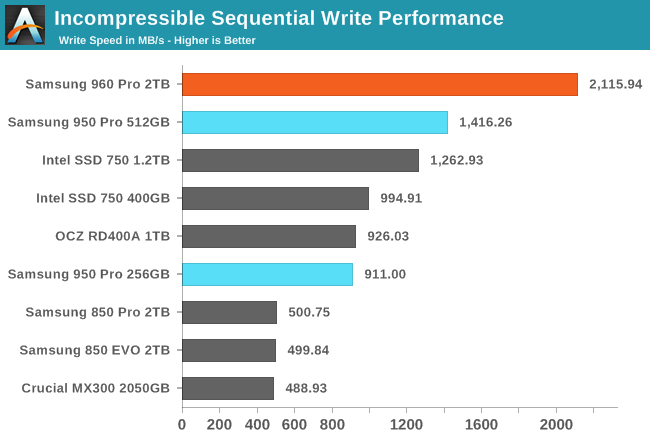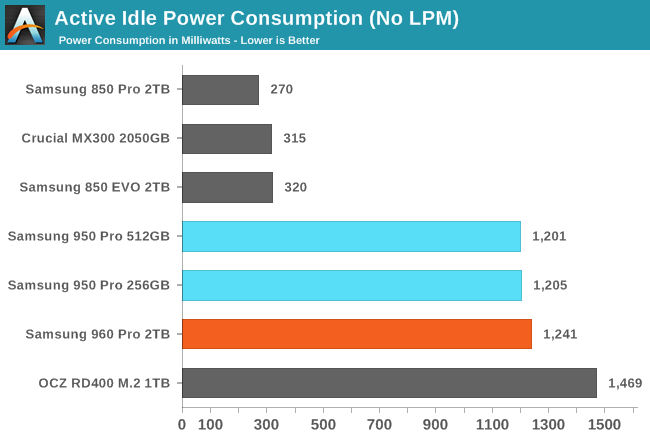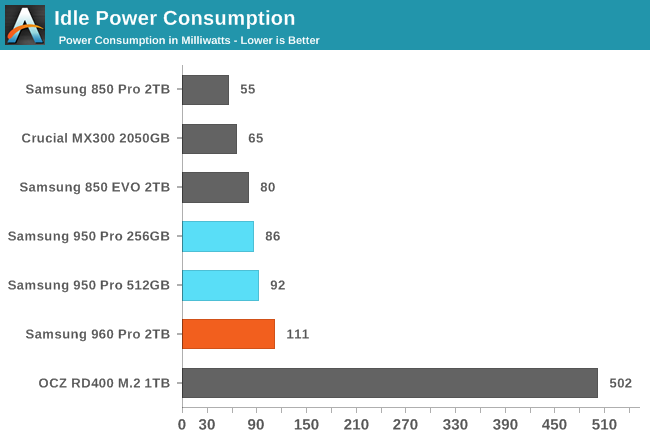The Samsung 960 Pro (2TB) SSD Review
by Billy Tallis on October 18, 2016 10:00 AM ESTATTO
ATTO's Disk Benchmark is a quick and easy freeware tool to measure drive performance across various transfer sizes.
 |
|||||||||
The 960 Pro hits full performance at 32kB or larger transfers, while the Intel SSD 750 doesn't reach its highest read speeds until 1MB transfers and the OCZ RD400 needs 512kB transfers for its highest read speeds. Unlike the 512GB 950 Pro, the 960 Pro does not hit any severe thermal throttling.
AS-SSD
AS-SSD is another quick and free benchmark tool. It uses incompressible data for all of its tests, making it an easy way to keep an eye on which drives are relying on transparent data compression. The short duration of the test makes it a decent indicator of peak drive performance.


The 960 Pro's read speed breaks away from the pack of other PCIe SSDs but still doesn't come close to the advertised 3.5GB/s. The write speed stands out even more and very slightly exceeds the advertised speed of 2100MB/s.
Idle Power Consumption
Since the ATSB tests based on real-world usage cut idle times short to 25ms, their power consumption scores paint an inaccurate picture of the relative suitability of drives for mobile use. During real-world client use, a solid state drive will spend far more time idle than actively processing commands.
There are two main ways that a NVMe SSD can save power when idle. The first is through suspending the PCIe link through the Active State Power Management (ASPM) mechanism, analogous to the SATA Link Power Management mechanism. Both define two power saving modes: an intermediate power saving mode with strict wake-up latency requirements (eg. 10µs for SATA "Partial" state) and a deeper state with looser wake-up requirements (eg. 10ms for SATA "Slumber" state). SATA Link Power Management is supported by almost all SSDs and host systems, though it is commonly off by default for desktops. PCIe ASPM support on the other hand is a minefield and it is common to encounter devices that do not implement it or implement it incorrectly. Forcing PCIe ASPM on for a system that defaults to disabling it may lead to the system locking up; this is the case for our current SSD testbed and thus we are unable to measure the effect of PCIe ASPM on SSD idle power.
The NVMe standard also defines a drive power management mechanism that is separate from PCIe link power management. The SSD can define up to 32 different power states and inform the host of the time taken to enter and exit these states. Some of these power states can be operational states where the drive continues to perform I/O with a restricted power budget, while others are non-operational idle states. The host system can either directly set these power states, or it can declare rules for which power states the drive may autonomously transition to after being idle for different lengths of time.
The big caveat to NVMe power management is that while I am able to manually set power states under Linux using low-level tools, I have not yet seen any OS or NVMe driver automatically engage this power saving. Work is underway to add Autonomous Power State Transition (APST) support to the Linux NVMe driver, and it may be possible to configure Windows to use this capability with some SSDs and NVMe drivers. NVMe power management including APST fortunately does not depend on motherboard support the way PCIe ASPM does, so it should eventually reach the same widespread availability that SATA Link Power Management enjoys.
We report two idle power values for each drive: an active idle measurement taken with none of the above power management states engaged, and an idle power measurement with either SATA LPM Slumber state or the lowest-power NVMe non-operational power state, if supported.

The active idle power consumption of the PCIe SSDs is still far higher than is typical for SATA SSDs, and is enough to keep their temperatures relatively high as well. The 960 Pro 2TB draws only slightly more power than the 950 Pro.

With power saving modes enabled, the Samsung NVMe SSDs are almost as efficient as typical SATA SSD, with the 960 Pro unsurprisingly drawing a little more power than the lower-capacity 950 Pros. The OCZ RD400 does benefit some from power management, but still draws far more than it should.










72 Comments
View All Comments
DanNeely - Tuesday, October 18, 2016 - link
Does your mobo power the m.2 slot, or just the LEDs? Baring evidence to the contrary I'd assume it's only the latter that are getting power, and enough residual power to run a few LEDs for a minute would only give a few seconds for the 960 in its deepest power saving modes, or far less while doing writes.bji - Tuesday, October 18, 2016 - link
How does your computer know to shut down in that event? Is there a signal to the operating system from the power supply to notify it that power has been lost and that it should shut down? Because if not, all that will happen is that 1 minute more of data will be written to the drive, only to be lost when the power abruptly cuts out when the capacitors lose their charge.ddriver - Tuesday, October 18, 2016 - link
Obviously it doesn't matter if the PSU doesn't send a signal to the system, which it doesn't. It wouldn't matter even if you have an UPS that could last an hour if it can't signal the system to shut down or at least flush caches before power runs out completely.noeldillabough - Tuesday, October 18, 2016 - link
I was thinking the exact same thing ACK no battery/capacitors? I'd never turn off buffer flushing.Billy Tallis - Tuesday, October 18, 2016 - link
I agree that what you've described is what those options *seem* to mean. But the semantics behind those checkboxes are clearly very different for NVMe drives and SATA drives, and it is an outright bug for Microsoft to apply the same description to both cases. The Samsung 960 Pro is also not the only drive to severely underperform without disabling write cache buffer flushing; the 950 Pro without Samsung's driver seems to be similar and I've seen this behavior on at least other vendor's NVMe controller. This is a serious concern that requires further investigation, but I'm not ready to lay the blame on the Samsung 960 Pro. If Microsoft's defaults for NVMe drives is the most reasonable behavior for consumer workloads (including the risk of power loss), then that would imply that most or all of the vendor-specific NVMe drivers are playing fast and loose with data safety, and possibly so are Microsoft's SATA/AHCI drivers.shodanshok - Tuesday, October 18, 2016 - link
"that would imply that most or all of the vendor-specific NVMe drivers are playing fast and loose with data safety, and possibly so are Microsoft's SATA/AHCI drivers"This can be quite true, especially considering as some vendors publish "turbo-cached mode" that supposedly enhance disk write speed. By the way the storage controller drives is such a critical kernel component that I will try hard to stay with Microsoft own driver, unless extensive testing on vendor-specific drivers confirms their stability.
HollyDOL - Tuesday, October 18, 2016 - link
Wouldn't INT 0 (power loss) fire fast enough to execute flush command in time for decent PSU to handle that before running out of power? Most of "decent+" PSUs seem to have quite a power buffer in capacitors to survive that long... with 300k IOPS it should manage to save with a decent margin.Even my old Corsair TX manages to survive micro-outages without computer shutting down or crashing. Afaic ATX2.01 PSU is required to endure at least 17ms power outage without losing output power. With 330k IOPS at hand it should be enough to quick save.
Not that I'd be all out to go and try :-)
beginner99 - Wednesday, October 19, 2016 - link
This would be something guys at anandtech could test. It would also probably help to build back the sites reputation and output of interesting articles.Create a script that does some file system operations, then pull the plug. Repeat 10 times for each drive, driver and settings and see what happens. Yeah a lot of work.
leexgx - Tuesday, October 25, 2016 - link
only intel SSDs that have super caps never lose data ,, Intel 320 and S3500 (some site tested it and only intel SSDs never corrupted some SSDs flat out failed the Crucial M4)http://lkcl.net/reports/ssd_analysis.html
http://www.extremetech.com/computing/173887-ssd-st...
normal SSDs that have small caps (not super caps) that say they have power loss protection that is only there to protect the page table from bee trashed not the data it self that is currently been written that still be loss
Gigaplex - Tuesday, October 18, 2016 - link
"then that would imply that most or all of the vendor-specific NVMe drivers are playing fast and loose with data safety"I would not be surprised if that's exactly what they're doing.